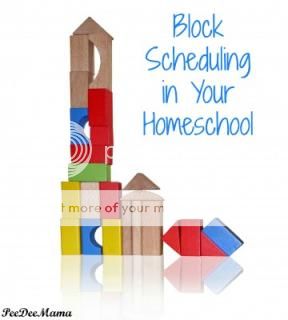For week six of our Summer Planning Series, we have TaMara from Tales of a Pee Dee Mama guest posting with us.
For the first time ever, I will be homeschooling a high school student
this year. This isn't my first year teaching high school, though; I
taught in one of the local public high schools for 3 years before having
children of my own. During that time, our school moved from traditional
scheduling to block scheduling. I really liked the concept and how it
worked then, so when I began planning for our homeschooling high school
years, block scheduling was one of my first decisions.
 Block
scheduling means that the student takes fewer classes a day, with each
class lasting longer than traditional scheduling allows. Traditionally
high school students take 7 to 8 units of credit, working on all 7 or 8
every day. Using block scheduling, students take 4 units of credit each
semester for a total of 8 at the end of the year.
Block
scheduling means that the student takes fewer classes a day, with each
class lasting longer than traditional scheduling allows. Traditionally
high school students take 7 to 8 units of credit, working on all 7 or 8
every day. Using block scheduling, students take 4 units of credit each
semester for a total of 8 at the end of the year.
What this looks like at our house:
The
Boy will work on 4 classes from August to December. This year it will
be Bible, Ancient Literature, Ancient History, and Computer Science.
Then he will work on 4 new classes from January to May. This year it
will be Chemistry, Geometry, Spanish I, and PE.
There are several benefits to block scheduling.
- Young people can focus on just a few subjects at a time, allowing for better retention and understanding.
- Young people can take sequential classes within the same school year. We're planning on The Boy doing Spanish 1 in the spring of this school year, Spanish 2 in the fall of the next year, and Spanish 3 in the spring of that year. Being able to move through this way should allow for better retention and less loss of knowledge between classes.
- Young people are better prepared for the semester schedule of most colleges. While transitioning from high school to college will still have its challenges, hopefully adjusting to having semester-long classes won't be one of them.
Anyone else using block scheduling in their homeschool?
 TaMara
is a homeschooling mama of 5 small people, ages 6 to 14. She's been
homeschooling for the past 10 years. Prior to that, she taught students
with learning disabilities in public school. She blogs about her
family's adventures in homeschooling and life at Tales of a Pee Dee Mama. You can also find her on Facebook and Twitter.
TaMara
is a homeschooling mama of 5 small people, ages 6 to 14. She's been
homeschooling for the past 10 years. Prior to that, she taught students
with learning disabilities in public school. She blogs about her
family's adventures in homeschooling and life at Tales of a Pee Dee Mama. You can also find her on Facebook and Twitter.In this Series:
Week 1: Who Plans Homeschool?
Week 2: Planning an Eclectic Homeschool School Year Type A Style
Week 3: Planned Unshooling . . . Why?
Week 4: Meal Planning Made Easy
Week 5: Managing Your Home When You Have an Irregular Schedule


Comments